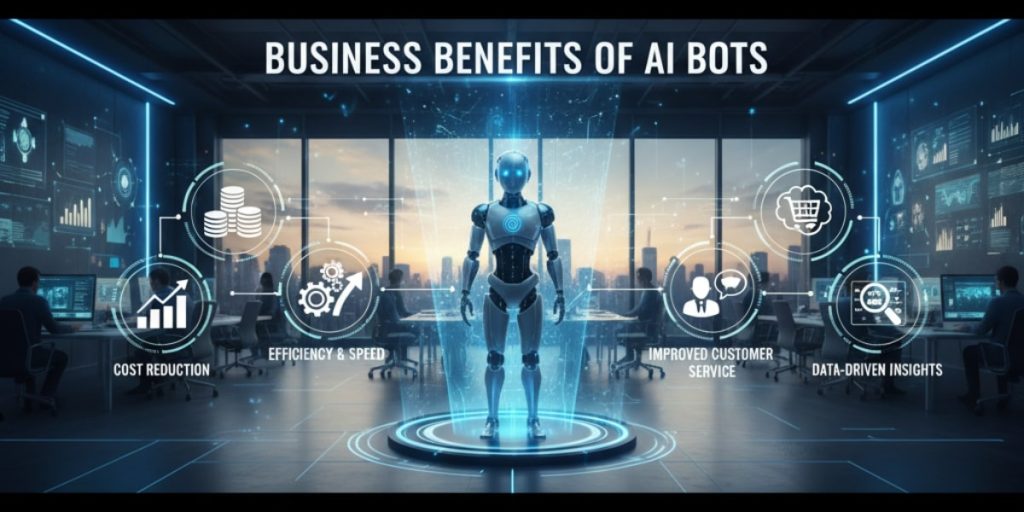
In today’s rapidly evolving digital landscape, businesses are under increasing pressure to innovate and stay ahead of the competition. AI bots have emerged as powerful tools that can automate tasks, enhance customer experiences, and unlock new growth opportunities. This comprehensive guide explores strategies, best practices, and future trends to help you future-proof your organization with AI bots.
According to recent studies, the global market for AI in customer service is expected to reach $3.1 billion by 2024, driven by the demand for faster response times and personalized interactions. Organizations that embrace AI bots can reduce operational costs, improve customer satisfaction, and gain valuable insights from user engagements, making them better positioned for long-term success.
What Are AI Bots?

AI bots are software applications powered by artificial intelligence algorithms that can understand language, make decisions, and perform tasks without constant human supervision. They range from simple chatbots that answer customer queries to advanced virtual assistants that orchestrate complex workflows. By leveraging natural language processing, machine learning, and predictive analytics, modern AI bots can engage users in meaningful conversations, recommend personalized solutions, and adapt to changing circumstances.
There are two main categories of bots: rule-based bots that follow predefined scripts and AI-driven bots that learn from interactions to improve over time. Rule-based bots excel at handling structured tasks with clear decision trees, while AI-driven bots employ deep learning techniques to handle ambiguous or open-ended scenarios, making them ideal for complex customer service and sales applications.
Business Benefits of AI Bots

Integrating AI bots into your business processes can yield significant benefits:
- 24/7 Customer Support: AI bots can handle routine inquiries around the clock, reducing response times and freeing up human agents for more complex issues.
- Cost Savings: Automating repetitive tasks minimizes manual labor costs and reduces the likelihood of human error.
- Scalability: AI bots can handle spikes in demand without compromising performance, ensuring a consistent user experience.
- Personalization: By analyzing customer data, AI bots can deliver targeted recommendations, boosting engagement and conversion rates.
- Data-Driven Insights: Interaction logs provide valuable analytics that can inform product development and marketing strategies.
Companies leveraging AI bots have reported an average ROI increase of 25% within the first year of deployment. By offloading mundane tasks to bots, employees can focus on higher-value activities such as strategy, innovation, and relationship building.
Key Strategies for Integration
Successful AI bot adoption requires a clear strategy:
- Define Clear Objectives: Identify specific use cases where AI bots can deliver measurable value, such as lead generation or support ticket resolution.
- Map User Journeys: Understand how customers interact with your organization and determine where AI bots can enhance or streamline these journeys.
- Choose the Right Technology Stack: Evaluate AI platforms, natural language processing tools, and integration frameworks that align with your technical environment.
- Collaborate Between Teams: Involve stakeholders from IT, customer service, marketing, and legal to address technical, operational, and compliance requirements.
- Emphasize User-Centric Design: Prioritize user experience by designing intuitive conversational flows and ensuring the bot can gracefully handle errors.
By aligning strategic goals with user needs, you set the foundation for a successful AI bot program that drives both efficiency and satisfaction.
Creating an Implementation Roadmap
An implementation roadmap provides a structured plan to guide your AI bot project:
- Assessment Phase: Audit existing processes and data sources to identify gaps and integration points.
- Proof of Concept: Develop a minimal viable bot to validate assumptions and gather user feedback.
- Pilot Deployment: Expand the bot’s capabilities, test in a controlled environment, and refine workflows.
- Full-Scale Rollout: Train staff, establish support protocols, and continuously monitor performance.
- Post-Launch Optimization: Use analytics to identify improvement areas, update intents, and enhance user satisfaction.
Stakeholder governance is crucial at each stage: establish clear ownership, define success metrics, and implement change management processes to ensure organization-wide alignment.
Training and Fine-Tuning AI Bots
High-quality training data is essential for AI bot accuracy. Collect diverse conversational logs and define clear intents and entities. Use supervised learning to label data and iterative testing to fine-tune responses. Continuously expand the bot’s knowledge base and incorporate user feedback to handle new queries effectively.
Advanced techniques like data augmentation, transfer learning, and real-time learning pipelines can help your AI bot adapt rapidly to emerging trends and customer behaviors. By retraining models with fresh data and leveraging A/B testing, you can continuously improve conversational quality and relevance.
Ensuring Security and Compliance
AI bot implementations must comply with data privacy regulations such as GDPR and CCPA. Encrypt sensitive data both in transit and at rest. Implement authentication mechanisms to prevent unauthorized access and regularly update your bots to patch security vulnerabilities. Conduct ethical reviews to ensure your AI systems operate transparently and fairly.
Adopt a privacy-by-design approach by minimizing data collection to only what is necessary, anonymizing user inputs where possible, and performing regular compliance audits. This proactive stance not only protects user trust but also shields your organization from potential legal and reputational risks.
Monitoring Performance and Metrics
Track key performance indicators (KPIs) to measure your AI bot’s impact:
- Response Time: Average time taken to resolve a user query.
- Completion Rate: Percentage of successful interactions versus escalated cases.
- User Satisfaction Score: Feedback collected through surveys or sentiment analysis.
- Cost per Interaction: Operational cost compared to manual handling.
Leverage advanced analytics and visualization dashboards to gain real-time insights. Set up automated alerts for performance anomalies, conduct regular health checks, and use A/B testing to evaluate new conversational flows before full deployment.
Overcoming Challenges and Risks
AI bot adoption can face several hurdles, including:
- Data Quality Issues: Inaccurate or incomplete data can lead to misunderstanding of user intent.
- Resistance to Change: Employees may fear job displacement or distrust automated systems.
- Integration Complexity: Legacy systems and data silos can hinder smooth integration.
- Maintaining Consistency: Ensuring the bot’s tone and messaging align with your brand voice.
- Bias and Fairness: Machine learning models can inherit biases, leading to unfair or discriminatory outcomes.
Address these challenges through stakeholder education, robust data governance, incremental deployment, and bias mitigation techniques. Conduct regular audits on bot interactions to detect and rectify unintended behavior.
Emerging Trends in AI Bots
The AI bot landscape continues to evolve with innovations such as:
- Conversational AI Platforms: Seamlessly integrate multimodal inputs, including voice and visual recognition.
- Emotionally Intelligent Bots: Detect user sentiment and respond with empathetic language.
- Hyper-Personalization: Leverage deep learning to deliver context-aware suggestions in real time.
- Edge AI Deployment: Run lightweight models locally to reduce latency and enhance privacy.
- Generative AI Integration: Use large language models to craft dynamic, human-like responses and creative copy.
These advancements are democratizing AI, enabling organizations of all sizes to harness sophisticated conversational agents for niche and enterprise use cases alike.
Case Studies and Success Stories
Several organizations have achieved impressive results with AI bots:
- Retail Giant: Implemented a shopping assistant bot that increased conversion rates by 20% and average order value by 15%.
- Financial Services: Deployed a compliance bot that reduced audit preparation time by 50%, freeing compliance teams to focus on strategic initiatives.
- Healthcare Provider: Leveraged a triage bot to handle 30% of patient inquiries, reducing wait times and improving care coordination.
- Global HR Firm: Developed a recruiting bot that handled initial candidate screening, cutting time-to-hire by 40% and improving candidate experience.
These examples demonstrate the diverse applications and tangible benefits of AI-driven automation across industries.
Conclusion and Next Steps
AI bots represent a transformative force in modern business, offering scalable, cost-effective, and personalized solutions. By following a structured approach—from defining objectives and mapping user journeys to monitoring performance and adopting emerging technologies—you can future-proof your organization and drive sustainable growth. Embrace the power of AI bots today to unlock new efficiencies and elevate the customer experience.
Ready to get started? Conduct a process audit, gather stakeholder buy-in, and start building a proof-of-concept AI bot. Pilot your solution, collect feedback, and iterate rapidly. The future of intelligent automation awaits—make your move now.
Want to automate lead generation, customer support, and personalization? Read our full guide:
AI Bots in Digital Marketing: Strategies and Best Practices to stay ahead of the curve.









Leave a Reply